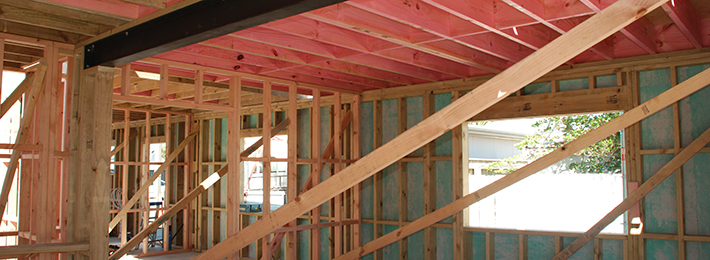Financial impact of natural disasters
20 Dec 2016, Featured

BRANZ has conducted extensive research into the costs and benefits of mitigating common natural hazards in housing. While some options are considered cost-effective, others hardly justify the expense
The New Zealand Building Code has a variety of measures aimed at ensuring the health and safety of occupants in buildings. However, these don’t aim to prevent extensive damage that may make a house uninhabitable for a considerable time after a disaster.
Earthquakes resulted in design changes
An example is the Christchurch earthquakes, where no lives were lost in housing but, five years on, some properties still haven’t been repaired.
Houses designed to NZS 3604:2011 Timber-framed housing generally performed well in these earthquakes. However, the extensive damage to foundations, claddings and linings revealed that unreinforced concrete foundations did not perform well in soft ground, particularly in areas subject to liquefaction. Changes now require different detailing of slab floors.
But is there a case for going further and reducing material damage for other components?
1. Adding bracing
If houses were stiffer, some or most of the damage caused by earthquakes and wind to linings and claddings could be avoided or reduced.
Modern houses have lots of openings in external walls and a large percentage of these walls are designed as bracing components. Additional bracing could be a cost-effective way to reduce subsequent repairs to linings.
If designers considered adding up to 50% more evenly distributed bracing, this would be expected to reduce lateral earthquake deflections and therefore damage. This can often be achieved using strengthened plasterboard, plywood sheet or similar.
Adding 50% more bracing in a single-storey light construction house in Wellington has an additional cost of about $1,600. If the earthquake occurred soon after construction, it’s money well spent.
However, on a probability basis – assuming a Building Code 500-year return period for houses – we would need to save about $45,000 per house in repair costs to justify the extra expenditure.
This appears unlikely based on results from the Christchurch earthquakes, where, of the inspected houses, 65% suffered zero or minimal damage to the linings.
BRANZ Study Report SR346 has a more detailed description of the analysis for this.
2. Floods
Another natural hazard is flooding. This mainly applies to older houses built on previously unrecognised flood plains.
Options for protection or repair:
If large-scale flood protection measures such as area-wide stop banks are not feasible, other options include:
- Replacing the damaged materials with like for like.
- Installing more resilient linings and insulation.
- Raising the house above flood levels.
- Building bunds around a house or a small group of houses.
In extreme cases, whole settlements have been moved to higher ground.
These are all quite expensive options and the preferred approach will depend on the flooding frequency.
BRANZ Study Report SR346 indicates that:
- For frequent floods (less than 20 years return period), raising the house above flood level is the cheapest option.
- For flooding frequency beyond 20 years, it may be cheaper to simply reinstate after every flood using the same or more resilient materials.
a) Increasing resilience of material
Replacing damaged components with more resilient materials after an initial flood costs more than like-for-like replacements, but can reduce future costs due to less damage and quicker reinstatement in future floods.
Depending on material cost assumptions, these two options work out to a similar lifetime cost.
b) Relocating or installing bunds
In contrast, using bunds, flexible membranes or moving a house to a new site are more expensive. The latter can be quite costly, as new land also needs to be purchased.
However, it is sometimes preferred for a small group of houses where community spirit is important and area-wide protection schemes are too expensive.
3. Wind damage
Upgrades for wind mainly apply to older existing houses, where fixings for roofs and windows are below current Building Code requirements.
Occasionally, coastal parts of New Zealand are subject to localised wind storms or tornadoes and roofs are damaged in these events.
a) Roof strengthening
BRANZ Study Report SR187: Retrofitting of houses to resist extreme wind events estimated roof strengthening costs up to $2,200 for houses built before 1999 in high or very high wind zones. This includes additional connections between trusses and purlins and, in some cases, fixing trusses to the top plate using L brackets.
b) Roof cladding fixings
Metal roof claddings are usually fixed to purlins with lead-head nails in older houses. These corrode with time, losing strength, and should be replaced. This can be done quite quickly and cheaply using galvanised or stainless screw fixings with flexible washers.
c) Window fixings
A 2012 revision of E2/AS1, the Acceptable Solution for New Zealand Building Code clause E2 External moisture, required extra fixings for window reveals to the building frame. These were added because updated wind suction pressure calculations indicated a risk of suction in certain conditions.
The occurrence of these roof and window events is rare and data on damage is sparse, so it’s difficult to do a cost-benefit analysis with any certainty.
At present, retrofit strengthening is not suggested as a matter of course on these houses. The roof cladding should, however, be screw-fixed as set out in BRANZ Study Report SR187.
If a house is in a very high or higher than average wind zone and exposed to storms, it may be wise to consult a building surveyor about installing additional purlins and top plate fixings.
As climate change proceeds, storms are expected to become more frequent in New Zealand. Assuming damage occurs more frequently, the advantages of retrofit strengthening may become more apparent in the future.
Register to earn LBP Points Sign in



